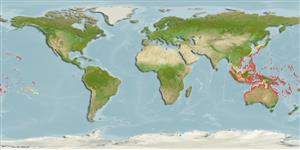Common names from other countries
Environment: milieu / climate zone / depth range / distribution range
Ecologia
marinhas associadas(os) a recifes; intervalo de profundidade 0 - 60 m (Ref. 128797). Tropical; 37°N - 32°S, 95°E - 134°W
Pacific Ocean: widespread from Japan and Australia to the Tuamoto Islands and Hawaii. Replaced by Chaetodon trifasciatus in the Indian Ocean (Ref. 37816). DNA (from tissue samples) expected to further distinguished Chaetodon lunulatus and Chaetodon trifasciatus (Ref. 86689).
Length at first maturity / Tamanho / Peso / Idade
Maturity: Lm ?, range 8 - 8.4 cm
Max length : 26.7 cm TL macho/indeterminado; (Ref. 124696); peso máx. Publicado: 191.24 g (Ref. 124696); Idade máx. registada: 12 anos (Ref. 56281)
Espinhos dorsais (total): 13 - 14; Raios dorsais moles (total): 20-22; Espinhos anais 3; Raios anais moles: 18 - 21.
Occur in monogamous pairs in coastal coral-rich areas (Ref. 47838, 48636). Juveniles hide among branches of small corals, often in lagoons (Ref. 9407). Benthopelagic (Ref. 58302). Feed solely on live corals (Ref. 47838). Oviparous (Ref. 205). Form pairs during breeding (Ref. 205).
Life cycle and mating behavior
Maturidade | Reprodução | Desova | Ovos | Fecundidade | Larvas
Pairs form upon maturation for breeding purposes (Ref. 56281).
Allen, G.R., R. Steene and M. Allen, 1998. A guide to angelfishes and butterflyfishes. Odyssey Publishing/Tropical Reef Research. 250 p. (Ref. 47838)
Categoria na Lista Vermelha da IUCN (Ref. 130435)
CITES (Ref. 128078)
Not Evaluated
Ameaça para o homem
Harmless
Utilização humana
Mais informação
ReferênciasAquaculturaPerfil para aquaculturaEstirpesGenéticaElectrophoresesHereditariedadeDoençasProcessamentoMass conversion
Ferramentas
Relatórios especiais
Descarregue XML
Fontes da internet
Estimates based on models
Preferred temperature (Ref.
115969): 24.7 - 29.3, mean 28.3 (based on 1779 cells).
Phylogenetic diversity index (Ref.
82804): PD
50 = 0.5000 [Uniqueness, from 0.5 = low to 2.0 = high].
Bayesian length-weight: a=0.02291 (0.01133 - 0.04632), b=3.00 (2.83 - 3.17), in cm Total Length, based on LWR estimates for this Genus-body shape (Ref.
93245).
Nível Trófico (Ref.
69278): 3.3 ±0.61 se; based on food items.
Resiliência (Ref.
120179): Elevada, tempo mínimo de duplicação da população menor que 15 meses (Preliminary K or Fecundity.).
Fishing Vulnerability (Ref.
59153): Low vulnerability (17 of 100).
